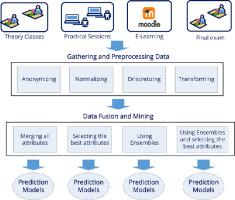当前位置:
X-MOL 学术
›
Comput. Electr. Eng.
›
论文详情
Our official English website, www.x-mol.net, welcomes your
feedback! (Note: you will need to create a separate account there.)
Multi-source and multimodal data fusion for predicting academic performance in blended learning university courses
Computers & Electrical Engineering ( IF 4.0 ) Pub Date : 2021-01-01 , DOI: 10.1016/j.compeleceng.2020.106908 Wilson Chango , Rebeca Cerezo , Cristóbal Romero
Computers & Electrical Engineering ( IF 4.0 ) Pub Date : 2021-01-01 , DOI: 10.1016/j.compeleceng.2020.106908 Wilson Chango , Rebeca Cerezo , Cristóbal Romero

|
Abstract In this paper we apply data fusion approaches for predicting the final academic performance of university students using multiple-source, multimodal data from blended learning environments. We collect and preprocess data about first-year university students from different sources: theory classes, practical sessions, on-line Moodle sessions, and a final exam. Our objective is to discover which data fusion approach produces the best results using our data. We carry out experiments by applying four different data fusion approaches and six classification algorithms. The results show that the best predictions are produced using ensembles and selecting the best attributes approach with discretized data. The best prediction models show us that the level of attention in theory classes, scores in Moodle quizzes, and the level of activity in Moodle forums are the best set of attributes for predicting students’ final performance in our courses.
中文翻译:

用于预测混合学习大学课程学业成绩的多源和多模态数据融合
摘要 在本文中,我们使用来自混合学习环境的多源、多模态数据应用数据融合方法来预测大学生的最终学业成绩。我们从不同来源收集和预处理关于一年级大学生的数据:理论课、实践课程、在线 Moodle 课程和期末考试。我们的目标是发现哪种数据融合方法可以使用我们的数据产生最佳结果。我们通过应用四种不同的数据融合方法和六种分类算法进行实验。结果表明,最好的预测是使用集成和选择离散数据的最佳属性方法产生的。最好的预测模型向我们展示了理论课的注意力水平、Moodle 测验的分数、
更新日期:2021-01-01
中文翻译:

用于预测混合学习大学课程学业成绩的多源和多模态数据融合
摘要 在本文中,我们使用来自混合学习环境的多源、多模态数据应用数据融合方法来预测大学生的最终学业成绩。我们从不同来源收集和预处理关于一年级大学生的数据:理论课、实践课程、在线 Moodle 课程和期末考试。我们的目标是发现哪种数据融合方法可以使用我们的数据产生最佳结果。我们通过应用四种不同的数据融合方法和六种分类算法进行实验。结果表明,最好的预测是使用集成和选择离散数据的最佳属性方法产生的。最好的预测模型向我们展示了理论课的注意力水平、Moodle 测验的分数、











































 京公网安备 11010802027423号
京公网安备 11010802027423号